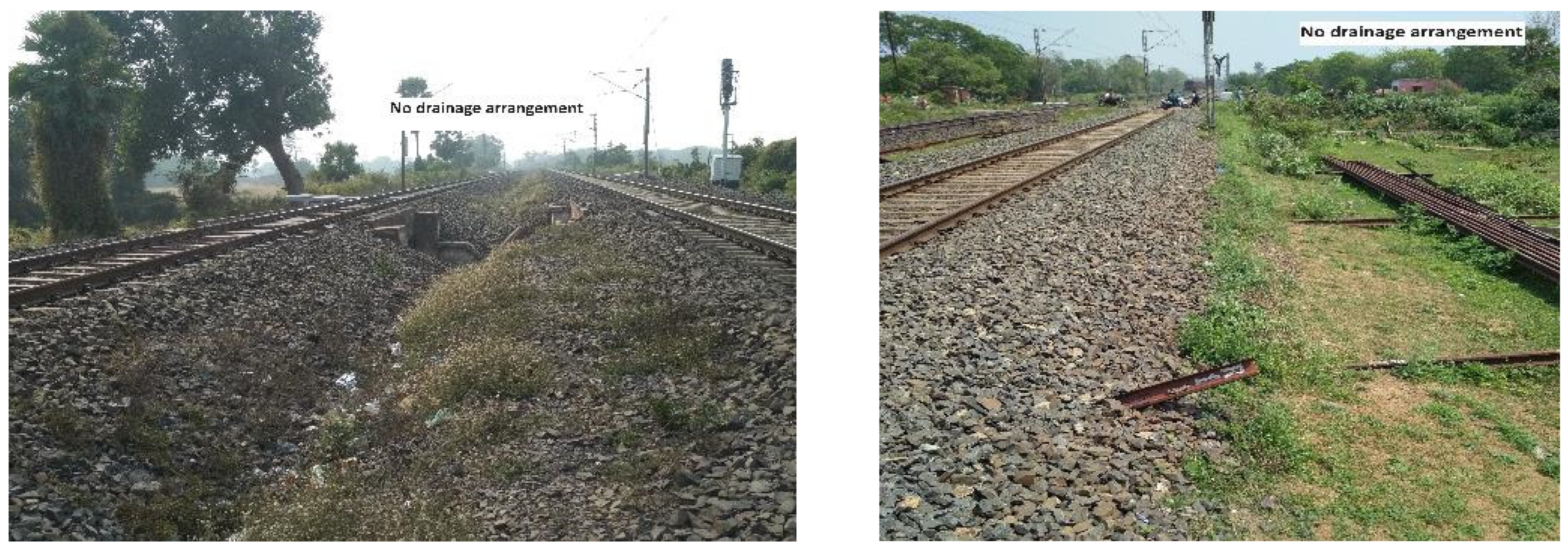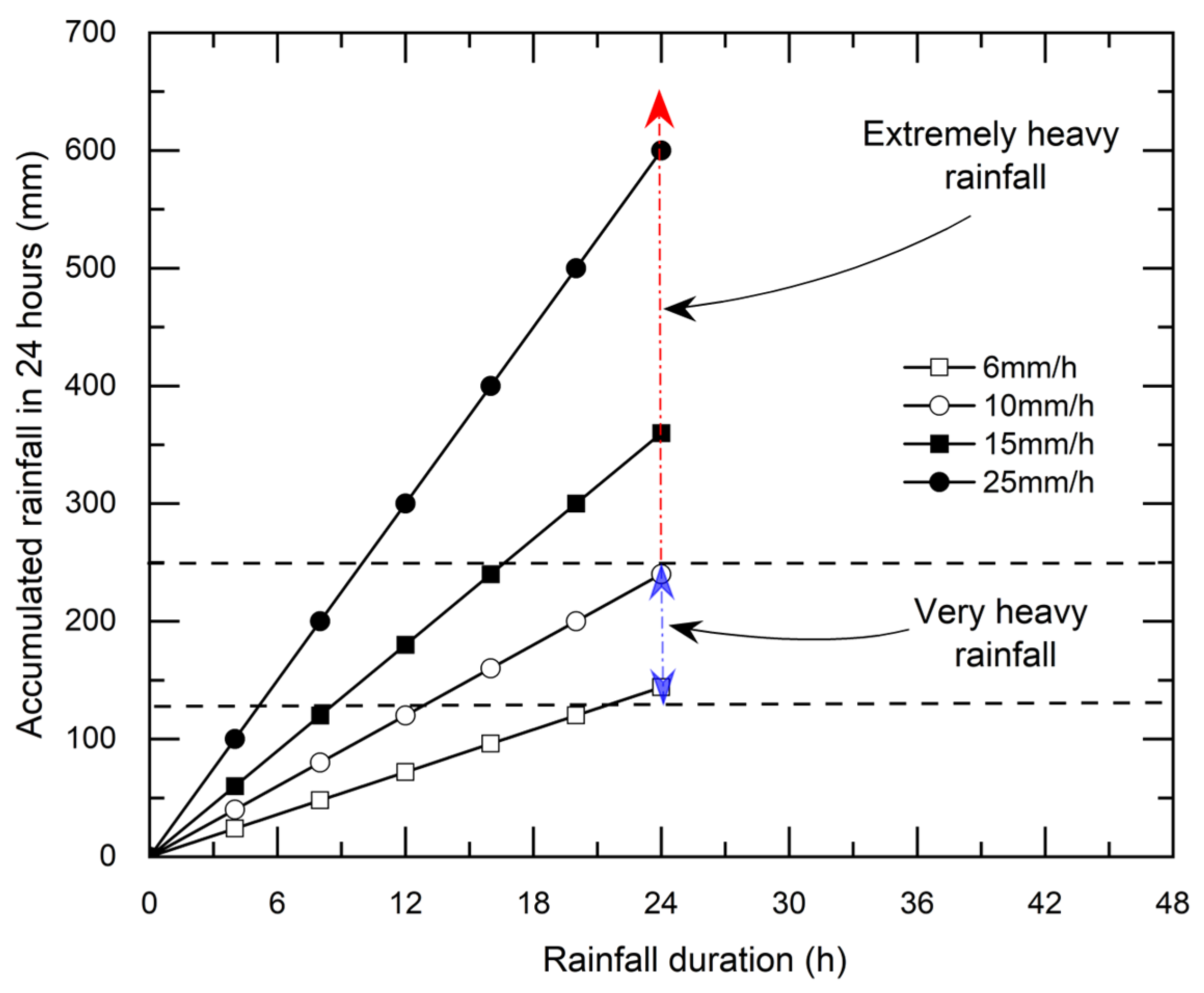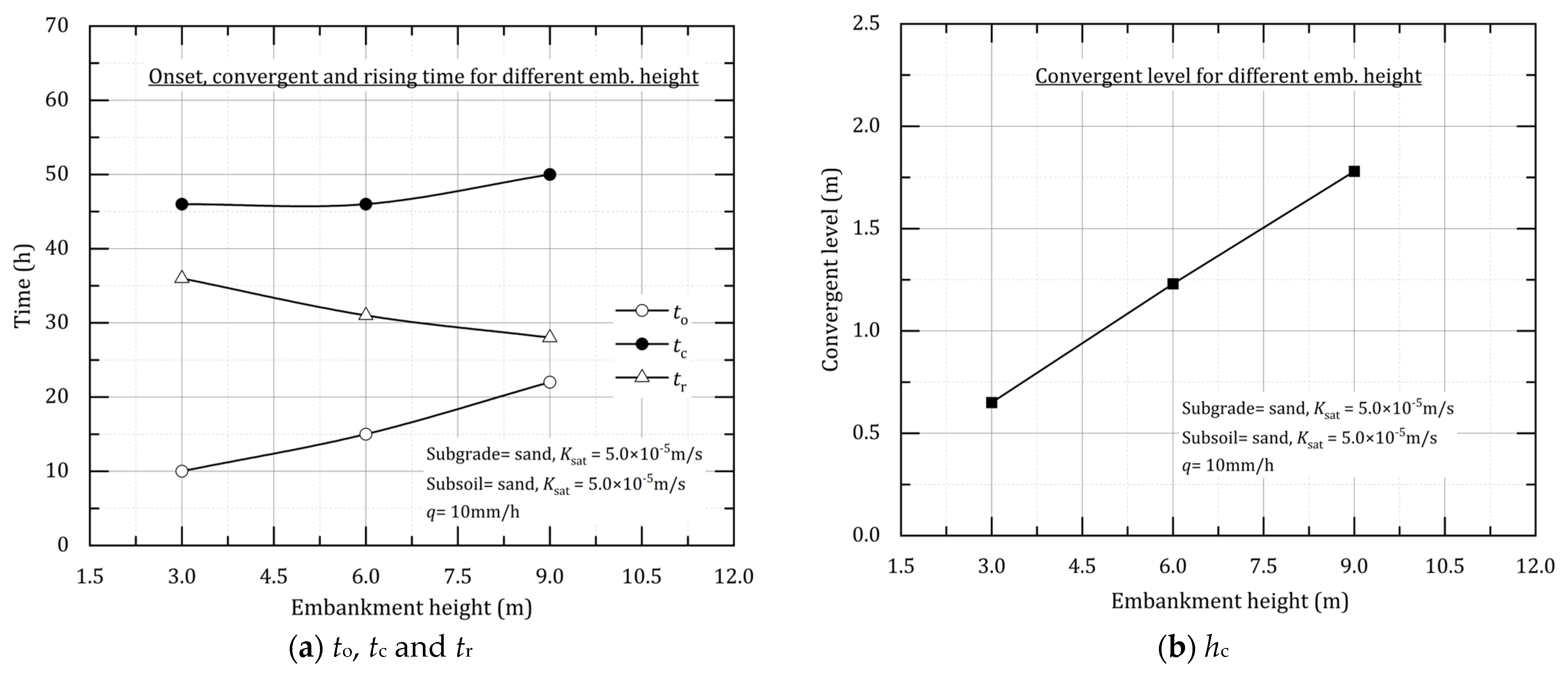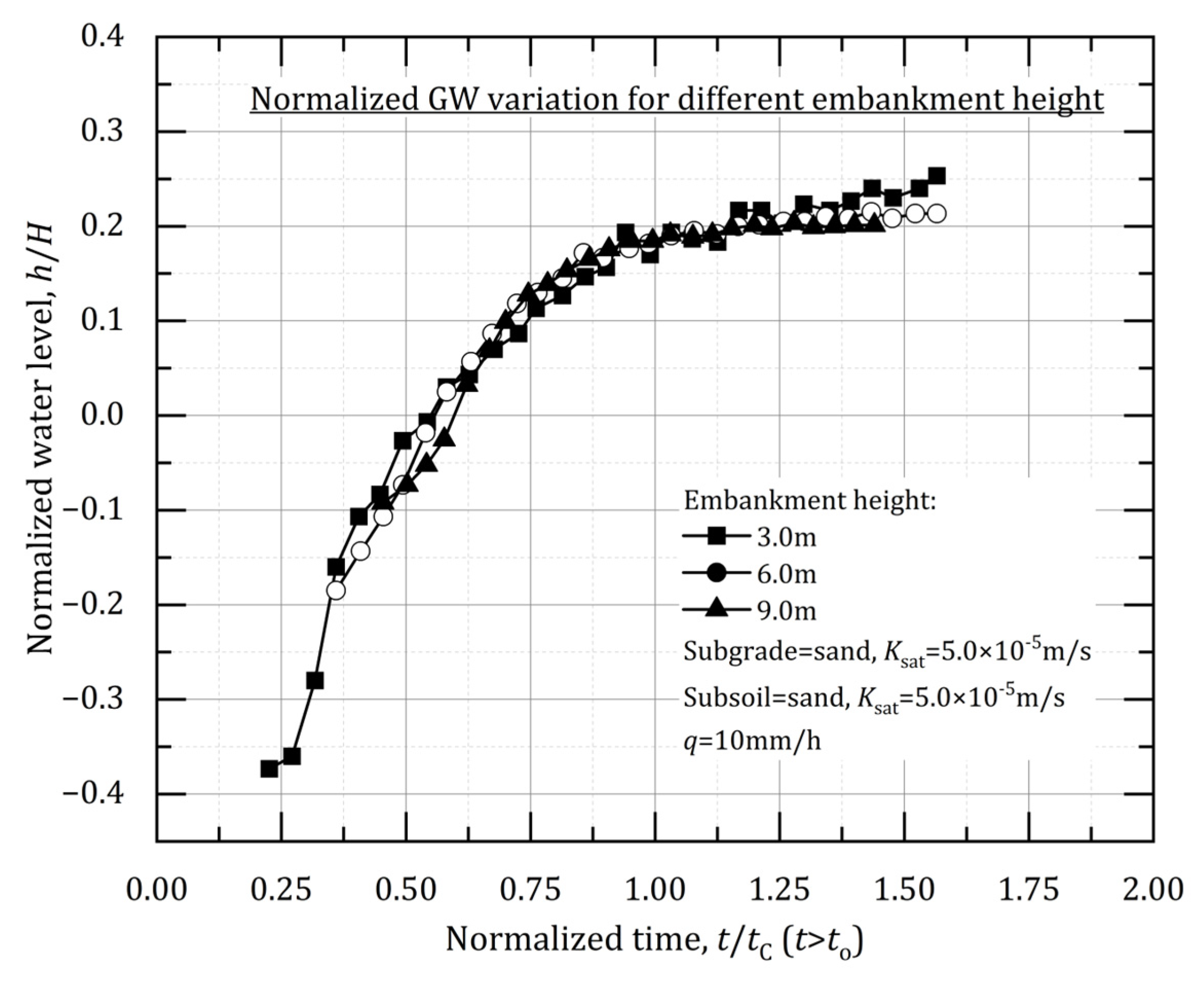Variation of the Groundwater Table within Indian Railway Embankments in Consideration of Climate Change
Abstract
:1. Introduction
2. Indian Railway Embankments and Foundation—Overview and Selected Specifications
2.1. Overview
2.2. Selected Specifications
3. Rainfall Trends and Selected Scenarios
- (i)
- 6 mm/h for 96 h;
- (ii)
- 10 mm/h for 72 h;
- (iii)
- 15 mm/h for 48 h;
- (iv)
- 25 mm/h for 24 h.
4. Methodology for Transient Unsaturated–Saturated Seepage Analysis
- ϴ = volumetric water content (m3 H2O/m3 soil);
- ϴr = residual volumetric water content (m3 H2O/m3 soil);
- ϴs = saturated volumetric water content (m3 H2O/m3 soil);
- α = fitting parameter associated with the air entry value of the soil (m−1);
- s = suction (m of H2O);
- n = fitting parameter associated with the rate of water extraction from the soil (dimensionless);
- m = (dimensionless).
- Rainfall scenario;
- Embankment height;
- Properties of the foundation and embankment materials;
- Initial position of the groundwater table.
5. Results
6. Discussion
6.1. Definition of Key Parameters
- (i)
- Onset time (to). This is the time when the groundwater level begins to increase significantly above its initial level. To determine the onset time, we drew a line along the steepest slope of the groundwater variation curve (step 1 in Figure 9a) and a horizontal line through the initial groundwater level (step 2). The point at which these two lines intersect indicates the onset time (step 3).
- (ii)
- Convergent time (tc). As shown in Figure 9, the variation in groundwater level becomes very little or negligible towards the end of rainfall. The time after which changes in the groundwater level become negligible can be defined as convergent time for a given set of parameters such as rainfall intensity, initial GWT depth, material, etc. To determine this, a line (step 1) connecting the initial and final positions of the groundwater level (shown in Figure 9b) was drawn and then offset upward (step 2) in +Y direction to become tangent to the rising limb of the curve. A horizontal line through the final groundwater level is also drawn (step 3). The convergence time is determined by the intersection of the tangent and horizontal lines (step 4).
- (iii)
- Rising time (tr). This is the critical period when the groundwater rises within the embankment, making it most vulnerable to failure. It is calculated as the difference between the convergence and onset times.
- (iv)
- Convergent level (hc). This is the level beyond which the variation in groundwater position becomes minimal or negligible. It was obtained by averaging the groundwater levels beyond the convergent time, as shown in Figure 9b.
6.2. Effect of Influencing Factors on the Key Parameters
6.3. Normalization of Influencing Factors
- h = water level, relative to the NGL (m);
- hc = convergent level for a given rainfall intensity (m).
- t = time (h);
- q = rainfall intensity (mm/h).
- h = water level, relative to the NGL (m);
- H = embankment height (m).
- t = time (h);
- tc = convergent time (h).
- Kh.avg = average permeability in the horizontal direction (mm/h);
- Z1 = thickness of soil layer 1, i.e., embankment soil (m);
- K1 = saturated permeability of embankment soil (mm/h);
- Z2 = thickness of soil layer 2, i.e., foundation soil (m);
- K2 = saturated permeability of foundation soil (mm/h);
- Z = total thickness of all layers = Z1 + Z2 (m).
7. Conclusions
- (i)
- Rapid groundwater rises with increased rainfall intensity. We found that groundwater rise within the embankment was directly proportional to rainfall intensity. With increasing intensity, the groundwater increased more rapidly to a higher convergence level. Due to climate change, the frequency of significantly heavy (124.5–244.4 mm in 24 h) and extremely heavy rainfall (>244.4 mm in 24 h) events is expected to rise, potentially making Indian railway embankments more vulnerable in the future and thereby indicating the need to strengthen railway embankments to enhance their resilience to climate change.
- (ii)
- Uniform groundwater onset mechanism across embankment heights. Regardless of embankment height, the groundwater onset mechanism remains consistent. Rainwater first infiltrates through side slopes, increasing groundwater levels near the toe region, followed by horizontal flow, leading to convergence. However, the rate of the water level increase was higher for taller embankments. A single normalized groundwater variation curve was derived, which is applicable for estimating water levels within railway embankments of any height.
- (iii)
- Convergence is dominated by horizontal flow. A unified plot of the normalized convergence level for different subgrades and subsoil materials can be created, assuming horizontal water flow through these layers. Despite the varied materials used in subgrade and subsoil across India, this mechanism allows for a rough prediction of the convergence level within railway embankments. Although this finding indicates that the horizontal flow is the predominant mechanism in terms of convergence, it would be appropriate to consider other aspects, such as vertical water transport and interaction with geological layers. The combination of these factors can influence the final state of groundwater level convergence in constructions, such as embankments.
- (iv)
- Unique convergence phenomena in low-permeability subsoils. A distinctive phenomenon was observed during the convergence period in the embankments over subsoils with low permeability, particularly under extremely heavy rainfall. The embankment top and side slopes were saturated; however, the bottom central portion and subsoil around the NGL remained unsaturated. In such cases, accurately determining the actual groundwater variation curve is challenging, and the derived curve may not accurately reflect the true water level within the embankment.
8. Limitations and Future Scope
- (i)
- In this study, only two subgrade soils, sand and sandy silt, belonging to categories SQ3 and SQ2, respectively, have been considered; however, in practice, some embankments are constructed with the very fine soil of SQ1 category, such as clay of low or medium plasticity [33]. Although such cases are rare, the effect of very fine subgrade soil on groundwater variation can be analyzed in a future study.
- (ii)
- This study focuses only on variations in the groundwater level through embankment height. However, in future prospects, it might be crucial to include the effect of the variation of water level on the stability and rainfall-induced settlement deformation of railway embankments, as performed by Sun et al. [55] and Gombert et al. [56].
- (iii)
- Flow-only analysis is conducted in this study, thereby establishing a unique convergence phenomenon in the case of low permeability subsoil; however, it does not explore the effect of such phenomena on the long-term stability of railway embankments, and it must be addressed in future studies.
- (iv)
- This thesis only studies changes in the water level, which is defined by pore water pressure; however, care must be taken, and in a future study, the changes in the internal stress state of the subgrade that might be happening because of changing water levels should be included.
- (v)
- Future research should consider the effects of evaporation, runoff, and drainage arrangements. Another potential area of study is the development of groundwater variation plots for scenarios with extremely heavy rainfall in which both the subgrade and subsoil exhibit very low permeability. Quantifying the critical rainfall duration and amount that compromises embankment safety presents another research opportunity.
Author Contributions
Funding
Institutional Review Board Statement
Informed Consent Statement
Data Availability Statement
Conflicts of Interest
Nomenclature
| h | Water level relative to the NGL (m) |
| hc | Convergent level (m) |
| H | Embankment height (m) |
| t | Time (h) |
| to | Onset time (h) |
| tr | Rising time (h) |
| tc | Convergent time (h) |
| q | Rainfall intensity (mm/h) |
| Ksat | Coefficient of saturated permeability (m/s) |
| Kh.avg | Average permeability in the horizontal direction (mm/h) |
| ϴ | Volumetric water content (m3 H2O/m3 soil) |
| ϴr | Residual volumetric water content (m3 H2O/m3 soil) |
| ϴs | Saturated volumetric water content (m3 H2O/m3 soil) |
| A fitting parameter related to the air entry value of the soil (m−1) | |
| A fitting parameter, which is a function of the rate of water extraction from the soil (dimensionless) | |
| s | Suction (m of H2O) |
References
- Sunil Kumar, D. Prepp by Collegedunia. Available online: https://prepp.in/news/e-492-railways-indian-economy-notes (accessed on 27 May 2024).
- Chitra, D.R.; Gupta, D.M. Geotechnical Investigations and Slope Stability Analysis of a Landslide. Int. J. Eng. Res. Technol. 2016, 5, 120–127. [Google Scholar]
- Davies, R. India-180,000 Evacuated After Floods in Bihar. Floodlist. 14 August 2017. Available online: https://floodlist.com/asia/india-floods-bihar-august-2017 (accessed on 15 October 2023).
- PGVS; Christian Aid. Flood Situation Report. PGVS. 2017. Available online: https://reliefweb.int/report/india/situation-report-bihar-floods-pgvs-ca-17082017 (accessed on 15 October 2023).
- Mehta, M.K. Maharashtra: Heavy Rain Disrupts Rail Traffic on Central Railway and Konkan Railway Routes. Times of India, 22 July 2021. Available online: https://timesofindia.indiatimes.com/city/mumbai/maharashtra-heavy-rain-disrupts-rail-traffic-on-central-railway-and-konkan-railway-routes/articleshow/84646564.cms (accessed on 15 October 2023).
- Indian Meteorological Department Climate Research and Services. Climate Summary for July 2021; Government of India, Ministry of Earth Sciences: New Delhi, India, 2021.
- Roy, P.; Martha, T.R.; Kumar, K.V.; Chauhan, P.; Rao, V.V. Cluster landlslides and associated damage in the Dima Hasao district of Assam, India due to heavy rainfall in May 2022. Landslides 2022, 20, 97–109. [Google Scholar] [CrossRef]
- Rajeevan, M.; Nayak, S. Observed Climate Variability and Change over the Indian Region; Springer Geology: New Delhi, India, 2016. [Google Scholar]
- Krishnan, R.; Sanjay, J.; Gnanaseelan, C.; Mujumdar, M.; Kulkarni, A.; Chakraborty, S. Assessment of Climate Change over the Indian Region; Springer: Pune, India, 2020. [Google Scholar]
- Raj, M.; Sengupta, A. Rain-triggered slope failure of the railway embankment at Malda, India. Acta Geotech. 2014, 9, 789–798. [Google Scholar] [CrossRef]
- Senthilkumar, V.; Chandrasekaran, S.S.; Maji, V.B. Geotechnical Characterization and Analysis of Rainfall-Induced 2009 Landslide at Marappalam Area of Nilgiris District, Tamil Nadu State; Springer: New Delhi, India, 2017. [Google Scholar]
- Ering, P.; Babu, G.L.S. Probabilistic back analysis of rainfall induced landslide-A case study of Malin landslide, India. Eng. Geol. 2016, 208, 154–164. [Google Scholar] [CrossRef]
- Juneja, A.; Chatterjee, D.; Kumar, R. Embankment failure in residual soils at Nivsar, Ratnagiri. Int. J. Geoengin. Case Hist. 2013, 2, 229–251. [Google Scholar]
- Aqib, M.; Usmani, S.; Khan, T.; Sadique, M.R.; Alam, M.M. Experimental and numerical analysis of rainfall-induced slope failure of railway embankment of semi high-speed trains. J. Eng. Appl. Sci. 2023, 70, 20. [Google Scholar] [CrossRef]
- Showkat, R.; Mohammadi, H.; Babu, G.S. Effect of Rainfall Infiltration on the stability of Compacted Embankments. Int. J. Geomech. 2022, 22, 04022104. [Google Scholar] [CrossRef]
- Chatra, A.S.; Dodagoudar, G.R.; Maji, V.B. Numerical Modelling of rainfall effects on the stability of soil slopes. Int. J. Geotech. Eng. 2019, 13, 425–437. [Google Scholar] [CrossRef]
- Dhanai, P.; Singh, V.P.; Soni, P. Rainfall Triggered Slope Instability Analysis with changing climate. Indian Geotech. J. 2022, 52, 477–492. [Google Scholar] [CrossRef]
- Shubhra, P.; Bashir, R.; Beddoe, R. Effect of climate change on earthen embankments in Southern Ontario, Canada. Environ. Geotech. 2021, 8, 148–169. [Google Scholar]
- Baninajarian, L.; Ghassemi, A.; Sangiuliano, T.; DeSira, A.; Bashir, R. Effect of Climate Change on Soil Embankment Stability. In Proceedings of the GeoSt.John’s 2019, The 72nd Annual CGS Conference, St. John’s, NL, Canada, 24 October 2019. [Google Scholar]
- Ng, C.; Tung, Y.-K.; Wang, B. Three-dimensional numerical investigations of groundwater responses in an unsaturated slope subjected to various rainfall patterns. Can. Geotech. J. 2021, 38, 1049–1062. [Google Scholar] [CrossRef]
- Rouainia, M.; Davies, O.; O’Brien, T.; Glendinning, S. Numerical modelling of climate effects on slope stability. Proc. Inst. Civ. Eng.-Eng. Sustain. 2009, 162, 81–89. [Google Scholar] [CrossRef]
- City Engineering and Testing Lab. Detailed Plan & L-Section for the Project of Final Location Survey in Connection with Doubling of B.G. Railway Line between Karaila Road and Shaktinagar from km 0.00 to 32.130 of Dhanbad Division, East Central Railway, India, 2018; Drawing no-488/D/LS-DHN/2019 (SH2/7); City Engineering and Testing Lab: Kolkata, India, 2019. [Google Scholar]
- Ministry of Railways, Govt of India. Indian Railways Schedule of Dimensions 1676 mm Gauge (BG); Ministry of Railways, Govt. of India: New Delhi, India, 2004.
- Research Designs and Standards Organisation, Ministry of Railways, Govt. of India. Guidelines on Erosion Control and Drainage of Railway Formation (Guideline no. GE: G-4); Research Designs and Standards Organisation, Ministry of Railways, Govt. of India: Lucknow, India, 2005.
- Research Designs and Standards Organisation, Ministry of Railways, Govt of India. Comprehensive Guidelines and Specifications for Railway Formation Specification no. RDSO/2020/GE: IRS-0044 (Including ACS No-01); Research Designs and Standards Organisation, Ministry of Railways, Govt. of India: Lucknow, India, 2020.
- East Central Railway, Ministry of Railways, Govt. of India. Geotechnical Investigation for Construction of Minor Bridge No 357 RCC Box between KPB-BUG Station of Narkatiaganj-Valmikinagar Doubling Work; East Central Railway, Ministry of Railways, Govt. of India: Narkatiaganj, India, 2018.
- Western Railway, Ministry of Railways, Govt. of India. Conducting Geo Technical Study by Soil Exploration with Bore Holes and Submitting Test Reports, Preparation and Submission of LWR Plans for Doubling between Surendranagar-Rajkot Stations in Connection with Doubling of Surendranagar-Rajkot Section; BR No-67; Western Railway, Ministry of Railways, Govt. of India: Ahmedabad, India, 2017.
- Western Railway, Ministry of Railways, Govt of India. Soil Investigation Work for the Work of Kanalus-Okha Provising RCC Box for Additional Opening (05 nos Locations); CH. 931/1-2; Western Railway, Ministry of Railways, Govt. of India: Jamnagar, India, 2022.
- East Central Railway, Ministry of Railways, Govt of India. Geotechnical Investigation Report for Minor Bridge No. 83, 84, 85, 86, 87, 88, 89, 90, 91, 92, 94; East Central Railway, Ministry of Railways, Govt. of India: Singrauli, India, 2017.
- South Eastern Railway, Ministry of Railways, Govt. of India. Subsoil Investigation for Construction of Proposed Construction of Normal Height Subway (NHS) (1 × 5.00 m × 5.00 m RCC Box) New Bridge No 91A at km 337.487 in Lieu of Manned LC No. TB-75 between OND-BMPR on TATA-BMPR Branch Line Section of CKP Division; South Eastern Railway, Ministry of Railways, Govt. of India: Dhanbad, India, 2021.
- West Central Railway, Ministry of Railways, Govt. of India. Geotechnical report of Jharkheda Syampur Railway Line work CH. 242+955; West Central Railway, Ministry of Railways. Govt. of India: Jharkheda, India, 2022.
- North Western Railway, Ministry of Railways, Govt. of India. Geotechnical Investigation Report for Construction Site of ROB at LC no 175, Khanbhakari, Dausa, Rajasthan; North Western Railway, Ministry of Railways, Govt. of India: Jaipur, India, 2020.
- RDSO/2007/GE:0014; To Assess the Availability of Subgrade Soil on Various Part of India and Its Cost Implication as per Specification Enumerated in Guidelines for Heavy Axle Load. Geo-Technical Engineering Directorate, Research Designs & Standards Organisation, Ministry of Railways, Govt. of India: Lucknow, India, 2011.
- Adapa, M.K.; Phalgun, M. Failure of a railway embankment on soft soil and its restoration. In Proceedings of the 16th Asian Regional Conference in Soil Mechanics and Geotechnical Engineering, Taipei, Taiwan, 14–18 October 2019. [Google Scholar]
- Chaudhuri, C.H.; Gangopadhyay, S.; Saha, D.R.; Ponnala, K. Failure Analysis of Railway embankment constructed on soft soil at Tripura—A case study. In Proceedings of the Sixth Indian Young Geotechnical Engineers Conference 6IYGEC2017, Trichy, India, 10–11 March 2017. [Google Scholar]
- Deshpande, T.D.; Kumar, S.; Begum, G.; Basha, S.; Rao, B.H. Analysis of Railway Embankment Supported with Geosynthetic-Encased Stone Columns in Soft Clays:A Case Study. Int. J. Geosynth. Ground Eng. 2021, 7, 43. [Google Scholar] [CrossRef]
- Kusaka, H.; Takahashi, A. Estimation of water level in road embankment by transient unsaturated seepage analysis. In Proceedings of the 2nd Pan-American Conference on Unsaturated Soils, Dallas, TX, USA, 12–15 November 2017. [Google Scholar]
- Central Ground Water Board, Ministry of Jal Shakti, Department of Water Resources, River Development and Ganga Rejuvenation, Government of India. Ground Water Year Book-India, 2022–2023; Central Ground Water Board, Ministry of Jal Shakti, Department of Water Resources, River Development and Ganga Rejuvenation, Government of India: New Delhi, India, 2023.
- Bhatla, R.; Verma, S.; Pandey, R.; Tripathi, A. Evolution of extreme rainfall events over Indo-Gangetic plain in changing climate during 1901–2010. J. Earth Syst. Sci. 2019, 128, 120. [Google Scholar] [CrossRef]
- Kumar, V.; Jain, S.K.; Singh, Y. Analysis of long-term rainfall trends in India. Hydrol. Sci. J. 2010, 55, 484–496. [Google Scholar] [CrossRef]
- Khaladkar, R.; Mahajan, P.; Kulkarni, J. Alarming Rise in the Number and Intensity of Extreme Point Rainfall Events over the Indian Region under Climate Change Scenario; Indian Institute of Tropical Meteorology: Pune, India, 2009. [Google Scholar]
- Dash, S.K.; Nair, A.A.; Kulkarni, M.A.; Mohanty, U.C. Characteristic changes in the long and short spells of different rain intensities in India. Theor. Appl. Climatol. 2011, 105, 563–570. [Google Scholar] [CrossRef]
- Mukherjee, S.; Aadhar, S.; Stone, D.; Mishra, V. Increase in extreme precipitation events under anthropogenic warming in India. Weather Clim. Extrem. 2017, 20, 45–53. [Google Scholar] [CrossRef]
- Ali, H.; Mishra, V.; Pai, D. Observed and projected urban extreme rainfall events in India. J. Geophys. Res. Atmos. 2014, 119, 12621–12641. [Google Scholar] [CrossRef]
- Goswami, B.N.; Venugopal, V.; Sengupta, D.; Madhusoodanan, M.S.; Xavier, P.K. Increasing trend of extreme rain events over India in a warming environment. Science 2006, 314, 1442–1446. [Google Scholar] [CrossRef]
- Rajeevan, M.; Bhate, J.; Jaswal, A.K. Analysis of variability and trends of extreme rainfall events over India using 104 years of gridded daily rainfall data. Geophys. Res. Lett. 2008, 35, L18707. [Google Scholar]
- Falga, R.; Wang, C. The rise of Indian summer monsoon precipitation extremes and its correlation with long-term changes of climate and anthropogenic factors. Sci. Rep. 2022, 12, 11985. [Google Scholar] [CrossRef] [PubMed]
- Chaubey, P.K.; Mall, R.K.; Jaiswal, R.; Payra, S. Spatio-temporal changes in extreme rainfall events over different Indian river basins. Earth Space Sci. 2022, 9, e2021EA001930. [Google Scholar] [CrossRef]
- Song, E.-X. Elasto-Plastic Consolidation under Steady and Cyclic Loads. Ph.D. Thesis, Delft University of Technology, Delft, The Netherlands, 1990. [Google Scholar]
- van Genuchten, M.T. A Closed form Equation for Predicting the Hydraulic Conductivity of Unsaturated Soils. Soil Sci. Soc. Am. J. 1980, 44, 892–898. [Google Scholar] [CrossRef]
- Roshan, M.J.; Rashid, A.S.A.; Wahab, N.A.; Hezmi, M.A.; Jusoh, S.N.; Azmi, M. Stability of railway embankment in saturated and unsaturated conditions. Mater. Sci. Eng. 2021, 1153, 012007. [Google Scholar] [CrossRef]
- Davies, O.; Rouainia, M.; Glendinning, S.; Birkinshaw, S.J. Assessing the influence of climate change on the progressive failure of a railway embankment. In Proceedings of the International Association for Computer Methods and Advances in Geomechanics (IACMAG), Goa, India, 1–6 October 2008. [Google Scholar]
- Khan, M.S.; Nobahar, M.; Stroud, M.; Amini, F.; Ivoke, J. Evaluation of rainfall induced moisture variation depth in highway embankment made of Yazoo clay. Transp. Geotech. 2021, 30, 100602. [Google Scholar] [CrossRef]
- Ganjian, N.; Pisheh, Y.P.; Hosseini, S.M.M.M. Prediction of soil-water characteristic curve based on soil index properties. In Experimental Unsaturated Soil Mechanics; Springer: Berlin/Heidelberg, Germany, 2007. [Google Scholar]
- Sun, J. Hard particle force in a soft fracture. Sci. Rep. 2019, 9, 3065. [Google Scholar] [CrossRef]
- Gombert, P.; Thoraval, A.; Watelet, J.-M. Geomechanical response of an abandoned chalk mine to multi-annual water table fluctuations. Bull. Eng. Geol. Environ. 2019, 78, 3353–3369. [Google Scholar] [CrossRef]





















| Height, H | 3.0 m, 6.0 m, 9.0 m |
| Blanket thickness | 0.60 m |
| Subgrade thickness | Embankment height − blanket thickness |
| Top width of single track | 7.0 m |
| Center-to-center distance between two tracks | 8.0 m |
| Side slope | 2H:1V |
| Slope at embankment top | Cross-slope of 1 in 30 in each line |
| Sub-bank (for height >6.0 m) | None |
| Groundwater table | 0.0 m, 1.5 m, and 3.0 m below ground level |
| Width of permeable strata/foundation, W | 400.0 m |
| Depth of permeable strata, D | 50.0 m |
| Rainfall Category | Daily Accumulated Rainfall (mm) |
|---|---|
| No rain | 0 |
| Very light rain | 0.1–2.4 |
| Light rain | 2.5–7.5 |
| Moderate rain | 7.6–35.5 |
| Rather heavy rain | 35.6–64.4 |
| Heavy rain | 64.5–124.4 |
| Very heavy rain | 124.5–244.4 |
| Extremely heavy rain | ≥244.5 |
| Soil | Embankment | Foundation | ||||
|---|---|---|---|---|---|---|
| Blanket | Subgrade | |||||
| SWCC Parameters | Sand (Blanket) | Sand (Subgrade) | Sandy Silt (Subgrade) | Sand | Clayish Sand | Silty Clay |
| ϴr | 0.14 | 0.17 | 0.21 | 0.18 | 0.19 | 0.21 |
| ϴs | 0.3 | 0.33 | 0.42 | 0.40 | 0.44 | 0.56 |
| α (1/m) | 3.4 | 2.1 | 1.2 | 3.82 | 1.4 | 0.3 |
| n | 4.4 | 4 | 1.6 | 4.14 | 2.1 | 1.5 |
| Ksat (m/s) | 5.0 × 10−5 | 5.0 × 10−5 | 5.55 × 10−6 | 5.0 × 10−5 | 1.2 × 10−5 | 3.3 × 10−7 |
| Influencing Factor | Onset Time, to | Convergent Time, tc | Rising Time, tr | Convergent Level, hc |
|---|---|---|---|---|
| Increase in rainfall intensity, q | Decreases (inversely proportional) | Decreases (inversely proportional) | Decreases (inversely proportional) | Increases (directly proportional) |
| Increase in embankment height, H | Increases (directly proportional) | Increases (especially for larger heights) | Decreases (inversely proportional) | Increases (directly proportional) |
| Decrease in the Ksat of foundation soil | Initially decreases slightly then increases rapidly | Decreases rapidly | Decreases rapidly | Increases rapidly |
| Decrease in the Ksat of embankment soil | Increases | Increases | Decreases | Increases |
| Increase in groundwater table depth | Increases (directly proportional) | Increases rapidly | Increases rapidly | Decreases |
Disclaimer/Publisher’s Note: The statements, opinions and data contained in all publications are solely those of the individual author(s) and contributor(s) and not of MDPI and/or the editor(s). MDPI and/or the editor(s) disclaim responsibility for any injury to people or property resulting from any ideas, methods, instructions or products referred to in the content. |
© 2024 by the authors. Licensee MDPI, Basel, Switzerland. This article is an open access article distributed under the terms and conditions of the Creative Commons Attribution (CC BY) license (https://creativecommons.org/licenses/by/4.0/).
Share and Cite
Kumar, M.; Hayano, K. Variation of the Groundwater Table within Indian Railway Embankments in Consideration of Climate Change. Sustainability 2024, 16, 6143. https://doi.org/10.3390/su16146143
Kumar M, Hayano K. Variation of the Groundwater Table within Indian Railway Embankments in Consideration of Climate Change. Sustainability. 2024; 16(14):6143. https://doi.org/10.3390/su16146143
Chicago/Turabian StyleKumar, Manish, and Kimitoshi Hayano. 2024. "Variation of the Groundwater Table within Indian Railway Embankments in Consideration of Climate Change" Sustainability 16, no. 14: 6143. https://doi.org/10.3390/su16146143





